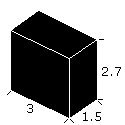Rigel Stardin
SOC-13
Need some to check my math here.
Ok, the standard Cargo Container is 3m by 1.5m by 3m. Which because of the deck height of 3m, I shrank to 2.7m based off real world examples so you could get it into a cargo bay without raising the roof. So a Cargo Container should be 3m by 1.5m by 2.7m that gives you 30 cm of clearance. So here comes the math:
3*1.5*2.7= 12.15 cubic meters.
Go to the interweb look up what is the weight of 1 cubic meter is kilograms. It turns out to be 1,000 Kg
Times 1000 by 12.2 (rounded up) 12,200 kilograms
Go back to the interwebs to check what a kilogram is in pounds. It 2.2 pounds which I knew but had to double check myself.
Fancy online caculator says it's 26896.396 pounds.
(BLINK, BLINK, muttering to myself 'that can't be right') that would mean a 1 Ton Cargo Container could carry 13.5 tons of cargo (Math: 26896.396 divded by 2,000 pounds)
So I double check myself again.
A single square is 1.5m by 1.5m by 3m =6.75m or 6.75 cubic meters.
Times that by 2 an it 13.5 cubic meters.
Times that by 1,000 kg and it becomes 13,500 kg .
Use fancy Caulator again, it says 29762.405 Pounds
Divide 29762.405 by 2,000 = 14.88 Tons
So, I go metric. Set to Pounds to Metric tons
Fancy Caculator: 12.2 Tons
13.5 Tons
So the math is telling me a 1 Ton Cargo Container can carry between 12.2 and 13.5 Metric tons of cargo?
SO either I'm wrong or the game system is? Because, isn't a Ton in game 13.5 Cubic Meters?
Ok, the standard Cargo Container is 3m by 1.5m by 3m. Which because of the deck height of 3m, I shrank to 2.7m based off real world examples so you could get it into a cargo bay without raising the roof. So a Cargo Container should be 3m by 1.5m by 2.7m that gives you 30 cm of clearance. So here comes the math:
3*1.5*2.7= 12.15 cubic meters.
Go to the interweb look up what is the weight of 1 cubic meter is kilograms. It turns out to be 1,000 Kg
Times 1000 by 12.2 (rounded up) 12,200 kilograms
Go back to the interwebs to check what a kilogram is in pounds. It 2.2 pounds which I knew but had to double check myself.
Fancy online caculator says it's 26896.396 pounds.
(BLINK, BLINK, muttering to myself 'that can't be right') that would mean a 1 Ton Cargo Container could carry 13.5 tons of cargo (Math: 26896.396 divded by 2,000 pounds)
So I double check myself again.
A single square is 1.5m by 1.5m by 3m =6.75m or 6.75 cubic meters.
Times that by 2 an it 13.5 cubic meters.
Times that by 1,000 kg and it becomes 13,500 kg .
Use fancy Caulator again, it says 29762.405 Pounds
Divide 29762.405 by 2,000 = 14.88 Tons
So, I go metric. Set to Pounds to Metric tons
Fancy Caculator: 12.2 Tons
13.5 Tons
So the math is telling me a 1 Ton Cargo Container can carry between 12.2 and 13.5 Metric tons of cargo?
SO either I'm wrong or the game system is? Because, isn't a Ton in game 13.5 Cubic Meters?


